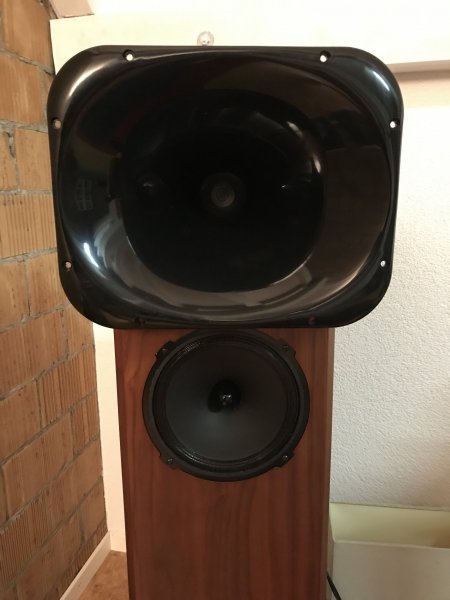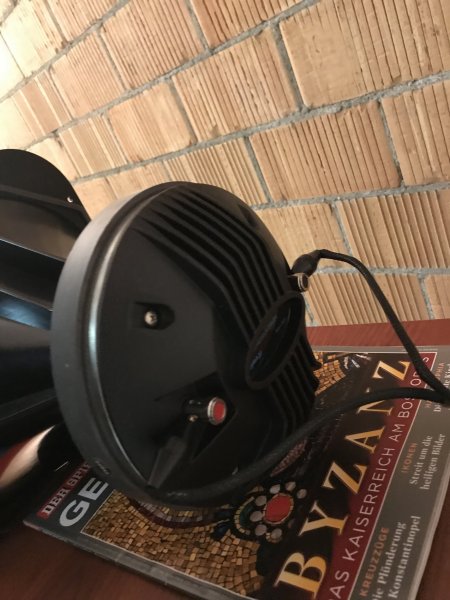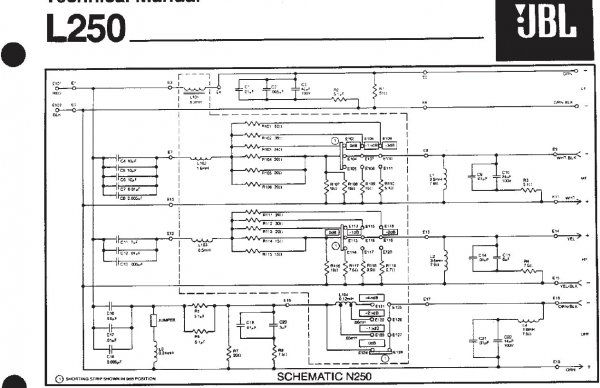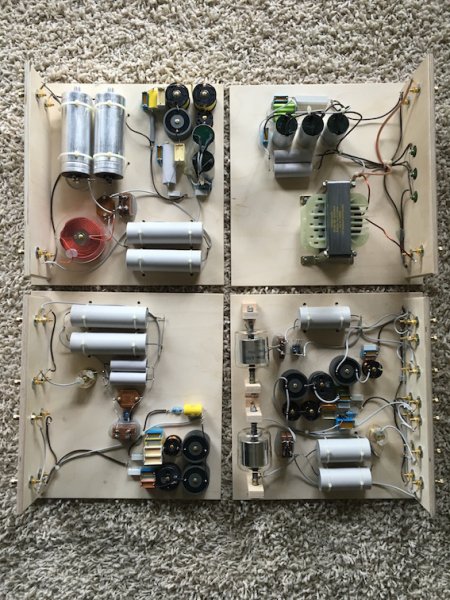What are the pros & cons of high-efficiency horns?
- Thread starter manisandher
- Start date
You are using an out of date browser. It may not display this or other websites correctly.
You should upgrade or use an alternative browser.
You should upgrade or use an alternative browser.
I am tempted to get an Iwata 600 and JMLC 600 from Poland to see how they compare with the 18 Sound ESS Elliptical constant directivity horns I am using now. These sound very uncolored.No the moral of the story is that nothing is perfect and there is no such an absolutist thing as What's Best in audio. Before I landed with Iwata i bought plastic round horns ,had wood round horns turned, i bought more fancy plastic round horns with Mick Jagger lips. I had a pair of something made that would not be out of place in a Dali painting. I absolutely hated the sound and was ready to walk away back to my Tympanis.
Carolus here persuaded me to have an Iwata made. The square one, that is the one so derided above. Before even hooking it up, my wife spoke through it. That was it. That was my horn. You heard Carolus's didn't you?
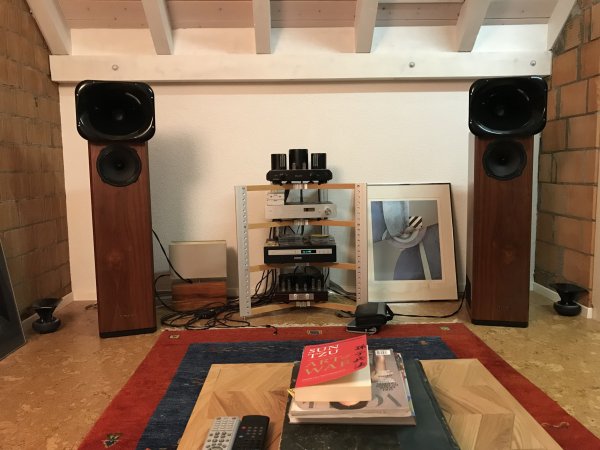
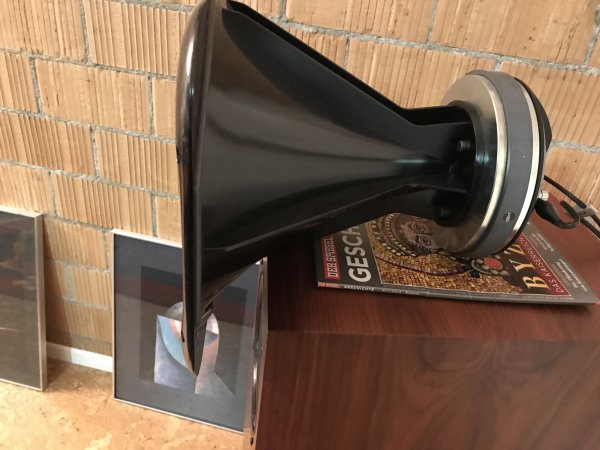
12db LR at 1000hz. Mild compensation for the constant directivity to give a flatter high end response and a small notch filter for a small peak around 1750hz. Mild eq on midbass to flatten and extend bass. Bass cabinet is a TQWT tuned around 45hz.
Sounds like he was never serious about plunging into DIY...(...)
Curiously I was. My audio life started DIY and in my student times I financed my audio activities traveling by interail to the UK, buying KEF speaker and crossover kits, building the boxes, having a good carpenter veneering them and later selling them. Great times, we (I was not alone in these trips) built many DIY projects of the british UK magazines, including huge transmission lines filled with special lambswool!
Before that some extra money was made in my student time repairing audio at a local shop. When needed I service almost all my gear, including rebuilding electrostatic speakers panels with success, either in the measurements and acoustically.
I have also built tube amplifiers, I have been a follower and contributor of audiodiy.com since long - I built my own gear to test tubes to complement my tube tester. Before buying the EMT927 I got a Garrard 401 using the advice of an WBF expert who advised me on how to built a plinth - only after such experiment I went on the EMT927. Can I be considered a serious DIY person?
Perhaps just because I take my hobbies too seriously I decided to not try to reproduce Paul Stublebinne system. As the sound of Tao
member wisely wrote at that point in time, after a long search using available information I could rely I could not be sure of the success of such venture, and particularly that the outcome would be more successful and enjoyable than using commercial high-end equipment.
I am lucky to have local distributors and friends with great rooms and systems that I can use as references to evaluate my evolution - and their diversity helps me to keep an open mind.
Part count and 6 db. Either LR with no caps, or simple LCR
I think there is a misconception that first order 6db networks are by definition, simple. They are actually difficult to implement well and they can require much more than a simple capacitor or inductor to work properly. Here is an example of a 6db network. Even taking out the stepped attenuation and replacing parallel caps with a single value this network is a bit more complex than many would expect for a 6db first order network. I attached a link to the design brief in anyone is interested,
http://www.audioheritage.org/vbulletin/showthread.php?4556-L250
Rob
Attachments
I think there is a misconception that first order 6db networks are by definition, simple. They are actually difficult to implement well and they can require much more than a simple capacitor or inductor to work properly. Here is an example of a 6db network. Even taking out the stepped attenuation and replacing parallel caps with a single value this network is a bit more complex than many would expect for a 6db first order network. I attached a link to the design brief in anyone is interested,
http://www.audioheritage.org/vbulletin/showthread.php?4556-L250
Rob
I am just going by the horns I hear and what those experts (that micro didn't meet) who made them told me.
another conclusion I´ve come to, is that a Nextel coated horn sounds smoother than a glossy piano finish
getting associations to the dimples in golf balls
mentioned this to Rune Skramstad, Bjørn Kolbræks doctorate tutor, and they wanted to calculate on it.......
beyond my math level....
actually one of the other guys who got the alu 2500 for the 2002 had it painted in Nextel
would be cool to compare....
getting associations to the dimples in golf balls
mentioned this to Rune Skramstad, Bjørn Kolbræks doctorate tutor, and they wanted to calculate on it.......
beyond my math level....
actually one of the other guys who got the alu 2500 for the 2002 had it painted in Nextel
would be cool to compare....
OK...even more surprising...Curiously I was. My audio life started DIY and in my student times I financed my audio activities traveling by interail to the UK, buying KEF speaker and crossover kits, building the boxes, having a good carpenter veneering them and later selling them. Great times, we (I was not alone in these trips) built many DIY projects of the british UK magazines, including huge transmission lines filled with special lambswool!
Before that some extra money was made in my student time repairing audio at a local shop. When needed I service almost all my gear, including rebuilding electrostatic speakers panels with success, either in the measurements and acoustically.
I have also built tube amplifiers, I have been a follower and contributor of audiodiy.com since long - I built my own gear to test tubes to complement my tube tester. Before buying the EMT927 I got a Garrard 401 using the advice of an WBF expert who advised me on how to built a plinth - only after such experiment I went on the EMT927. Can I be considered a serious DIY person?
Perhaps just because I take my hobbies too seriously I decided to not try to reproduce Paul Stublebinne system. As the sound of Tao
member wisely wrote at that point in time, after a long search using available information I could rely I could not be sure of the success of such venture, and particularly that the outcome would be more successful and enjoyable than using commercial high-end equipment.
I am lucky to have local distributors and friends with great rooms and systems that I can use as references to evaluate my evolution - and their diversity helps me to keep an open mind.
Maybe it helps to minimize the high order modes (HOMs) that led Earl Geddes to put foam plugs in his oblate spheroid horn/waveguides?another conclusion I´ve come to, is that a Nextel coated horn sounds smoother than a glossy piano finish
getting associations to the dimples in golf balls
mentioned this to Rune Skramstad, Bjørn Kolbræks doctorate tutor, and they wanted to calculate on it.......
beyond my math level....
actually one of the other guys who got the alu 2500 for the 2002 had it painted in Nextel
would be cool to compare....
another conclusion I´ve come to, is that a Nextel coated horn sounds smoother than a glossy piano finish
That's interesting JBL uses a Nextel finish on the Array and Synthesis horns. Horn in my avatar is an Array. It's wild as it actually almost feels soft, it's so smooth.
Rob
How do you define a simple crossover?? Part count?? Order??
From the amplifier's point of view, a "simple crossover" may well be the one that results in the most benign impedance curve, something seldom achieved by a "minimize-the-parts-count" approach.
(Imo a good speaker should get along well with its neighbors in the audio chain, namely the room and the amplifier. The speaker's radiation characteristics plus frequency response interact with the room, and its impedance curve plus efficiency interact with the amplifier.)
Last edited:
Very nice multi-layered non-resonant limited-edition German-engineered support unit for your compression driver.
Speaking of which, is it a Beyma?
From the amplifier's point of view, a "simple crossover" may well be the one that results in the most benign impedance curve, something seldom achieved by a "minimize-the-parts-count" approach. (...)
Dynaudio was a known case of this paradigm - they used ( 90's, early 00's) to design crossovers to have a regular benign impedance. But they were extremely complex, a good percentage of components was used to linearize the impedance.
OK...even more surprising...
People should read the 1995 lovely publication from Dynaudio "The Book of Truth". Although a good sense of humor and understanding is needed to appreciate it, is is filled with even more surprises!
Here are my "simple" first order (6db/oct) filters. To make a first order filter work, you would need good compensation as well. While having all these parts you have to have a transparent network still!
Here you can see the crossovers for just one side so I have four more for the other side. One note is the one on top right was for my bass. That is gone now as I changed my bass to open baffle servo and they have their own servo amps and crossovers.
Here you can see the crossovers for just one side so I have four more for the other side. One note is the one on top right was for my bass. That is gone now as I changed my bass to open baffle servo and they have their own servo amps and crossovers.
Attachments
another conclusion I´ve come to, is that a Nextel coated horn sounds smoother than a glossy piano finish
getting associations to the dimples in golf balls
mentioned this to Rune Skramstad, Bjørn Kolbræks doctorate tutor, and they wanted to calculate on it.......
beyond my math level....
actually one of the other guys who got the alu 2500 for the 2002 had it painted in Nextel
would be cool to compare....
That is what I found out, my horns have rough finish towards their throats and more refined finish towards the mouth.
I have also tried, listened and measured various densities and structures of foam in my 1400hz jmlc horn and ended up with 30ppi reticulated foam (open cell structure) This relaxes the sound without loosing any of the details.
Very nice multi-layered non-resonant limited-edition German-engineered support unit for your compression driver.
Speaking of which, is it a Beyma?
Yes, finest quality
The driver is a Beyma CP755Ti.
Ah so you are doing the Geddes foam thing in the horn as well?That is what I found out, my horns have rough finish towards their throats and more refined finish towards the mouth.
I have also tried, listened and measured various densities and structures of foam in my 1400hz jmlc horn and ended up with 30ppi reticulated foam (open cell structure) This relaxes the sound without loosing any of the details.
Here are my "simple" first order (6db/oct) filters. To make a first order filter work, you would need good compensation as well. While having all these parts you have to have a transparent network still!
Here you can see the crossovers for just one side so I have four more for the other side. One note is the one on top right was for my bass. That is gone now as I changed my bass to open baffle servo and they have their own servo amps and crossovers.
Of course they can be simple if you don’t care all that much about linearizing impedance or frequency response. I have experienced situations where the removal of one of these networks completely improved the sound despite measuring worse. Did you start simpler and advance to this complexity?
Similar threads
- Replies
- 58
- Views
- 7K
- Replies
- 64
- Views
- 7K
- Replies
- 2
- Views
- 1K
- Replies
- 9
- Views
- 5K


